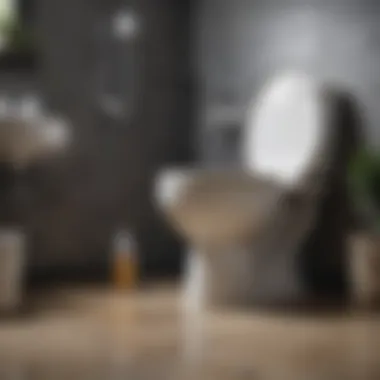Understanding Toilet Flush Issues and Solutions


Intro
The issue of water not going down in the toilet is a widespread problem that many homeowners face. This situation can lead to frustration and inconvenience, especially when a functional bathroom is essential for everyday life. Understanding this problem requires looking at several aspects, including potential causes, diagnostic steps, and solutions.
In this article, we will examine common reasons behind toilet flushing issues. By addressing these problems, homeowners can maintain the functionality of their bathrooms, ensuring that the plumbing works efficiently. We will discuss several technical details and practical tips that can aid in resolving these issues effectively.
Preamble to Toilet Problems
Understanding common toilet problems is crucial for homeowners and property managers. A clogged toilet is not just an inconvenience; it can lead to more significant plumbing issues if not addressed promptly. Additionally, a malfunctioning toilet can disrupt daily routines and affect overall hygiene. This article explores various toilet problems, particularly the issue of water not going down. We aim to provide readers with practical strategies and insights that can help remedy these issues efficiently.
Common Toilet Issues
Toilets can experience a range of problems. Some of the most common include:
- Clogs: This is perhaps the most frequent issue. A blockage can prevent water from flushing properly.
- Leaks: Water may leak from the tank, causing waste and higher water bills.
- Flushing Problems: A weak flush may leave waste unremoved, leading to multiple flush attempts.
- Running Toilet: Continuous water running from the tank can waste significant amounts of water and increase costs.
The ability to recognize these issues can empower homeowners to take timely action before the problems escalate.
Significance of Proper Functionality
Ensuring that a toilet functions correctly is essential for several reasons. First, it impacts the comfort and cleanliness of the bathroom environment. A clogged or malfunctioning toilet can lead to unpleasant odors or unsanitary conditions.
Secondly, the financial implications should not be overlooked. A running toilet, for example, can waste several gallons of water per day, leading to excessive utility bills. Maintaining proper functionality can ultimately save money while contributing to environmental conservation by minimizing water waste.
Immediate Causes of Water Blockage
Understanding the immediate causes of water blockage in toilets is crucial for any homeowner. It provides insight into why a toilet might not flush properly and can therefore guide effective troubleshooting. Recognizing these specific causes can prevent longer-lasting damage and costly repairs. The focus areas include clogs and flushing mechanism issues, which are common sources for this problem. Having a grasp of these causes helps in streamlining the correction process and ensuring a functional bathroom.
Clogs in the Toilet
Clogs are often the first thing to consider when dealing with a toilet that won't flush. They can be categorized into soft and hard clogs, each requiring different identification techniques.
Identifying Soft Clogs
Soft clogs are typically associated with non-solid items that get stuck in the toilet trap or the drain. These can include paper products, sanitary items, or even too much toilet paper. One of the key characteristics of soft clogs is their ability to yield to pressure, making them possibly easier to clear. They contribute to the overall topic by being the most common clog type, encountered frequently in household settings.
Identifying a soft clog usually involves a visual inspection. A telltale sign includes water that might slowly pool in the bowl during a flush. This indicates that water can't flow smoothly through the drain. The advantage of focusing on soft clogs is that they can often be resolved with a simple plunger or by using enzymatic drain cleaners.
Identifying Hard Clogs
Hard clogs are different and generally more challenging. They often consist of solid objects like toys, small bottles, or any debris that settles deeper within the plumbing system. The key characteristic of hard clogs is their inability to dissolve or be pushed through easily. They are vital to recognize because they often require more intensive solutions to remedy.
Recognizing a hard clog frequently involves listening for unusual gurgling sounds during flushing or observing water that fails to go down at all. The unique feature of hard clogs is their potential to cause damage to toilet components if ignored. They usually require a snake tool or professional assistance to remove. The disadvantage is that they can escalate into costly repairs if not addressed promptly.
Issues with Flushing Mechanism
Flushing mechanisms can also lead to water blockage. Problems with components such as the flapper valve and chain misalignment can disrupt the flushing process, causing stagnant water.
Flapper Valve Failures


Flapper valve failures occur when the valve that seals the tank water becomes faulty. This failure can result in either a failure to fully flush or a toilet that continuously runs. The key characteristic of this issue is its subtlety; it often goes unnoticed until flushing becomes problematic. Addressing flapper valve failures is beneficial as they can be easily replaced, restoring toilet functionality swiftly.
A unique advantage is that replacing a flapper valve is low-cost and can drastically improve flushing efficiency. However, if overlooked, it may lead to longer periods of water waste and increased utility bills.
Chain Misalignment
Chain misalignment happens when the chain connecting the flush handle to the flapper valve becomes tangled or too tight. This issue can prevent the flapper from lifting properly during a flush. The key characteristic of this problem lies in its mechanical nature. Fixing chain misalignment is straightforward yet sometimes overlooked during inspections.
When properly addressed, chain alignment can significantly enhance the flushing operation. The disadvantage, however, is that if ignored, it can lead to more complex issues in the toilet’s flushing system.
Understanding these immediate causes provides a foundation for timely interventions, preventing more extensive plumbing issues down the line.
Diagnostic Steps to Identify the Cause
Identifying the cause of water blockage in a toilet is essential for effective remediation. Without a proper diagnosis, attempts at resolving the issue may be ineffective or lead to further complications. This section outlines the necessary steps to diagnose the problem accurately, emphasizing the importance of not overlooking any details.
Visual Inspection
Examining the Toilet Bowl
Examining the toilet bowl is a crucial first step in diagnosing flushing issues. It allows you to see instantly if there is visible debris or buildup that could prevent proper water flow. A straightforward inspection can reveal soft clogs caused by items that break down easily, like toilet paper or organic matter. It is often seen as beneficial because it does not require any tools or special knowledge. By simply looking at the bowl, homeowners can gain insight into potential problems without incurring costs.
However, this method does have limitations. Some issues may not be visible from the bowl, such as deeper obstructions or problems within the tank. Still, this examination provides a solid starting point for further investigation.
Checking the Tank
Checking the tank is another significant diagnostic measure. Issues within the tank can directly impact the toilet's ability to flush properly. Look for signs of malfunction, such as a flapper valve that is not sealing properly or low water levels that prevent adequate flushing pressure. This method highlights the critical relationship between tank mechanics and overall toilet function.
One major advantage of checking the tank is that it can often be done without professional assistance. Homeowners can detect simple issues like chain misalignment or leaks by lifting the tank lid and observing the components. On the downside, challenging problems like malfunctioning mechanisms may require expert attention. Thus, while tank inspection is highly informative, it should be part of a broader diagnostic strategy.
Plumbing Tools for Diagnosis
Using a Plunger
Using a plunger is often the first response to a clogged toilet. The tool is designed specifically to dislodge blockages caused by excessive waste or toilet paper build-up. It involves creating a vacuum seal and then utilizing upward and downward thrusts to break through the obstruction. This method is well-regarded for its ease of use and direct action on the problem.
The key characteristic of a plunger is its simplicity. Most homeowners can use it without extensive plumbing knowledge. However, it's essential to use the right technique. Otherwise, the problem may persist, and additional tools might be necessary. Nevertheless, for immediate action against clogs, the plunger is often a good starting point, though its effectiveness may vary depending on the nature of the blockage.
Employing a Snake Tool
Employing a snake tool is another option for diagnosing persistent clogs that resist plunging. This device can reach much deeper into the plumbing system, making it effective against stubborn blockages. It works by providing the ability to navigate through bends and curves in the pipes, reaching obstructions that might be out of reach for a standard plunger.
The unique feature of a snake tool is its versatility. It can be used for various plumbing issues beyond just toilets, such as sinks or showers. While it is more effective for serious clogs, using it requires some learning and finesse. Improper use may lead to damage in the plumbing system. Overall, employing a snake tool is well-regarded within the diagnostic process, especially for more complicated issues that do not respond to simpler methods.
By integrating these diagnostic steps, homeowners can systematically approach toilet issues. This not only saves potential time and resources but also enhances the chances of achieving a functional and effective bathroom environment.
Common Remedies and Solutions
When plumbing issues arise, particularly when water won't go down in a toilet, understanding the available remedies is essential. This article highlights the significance of exploring solutions that can effectively address the root causes leading to stagnant water. Recognizing these remedies not only enables homeowners to save time but can also prevent potential damages related to plumbing failures.


Unclogging Techniques
Manual Methods
Manual methods are a key approach to unclogging toilets. They typically involve physical tools such as a plunger or a toilet auger, which directly address the blockage. One key characteristic of manual methods is their accessibility; they do not rely on chemical agents and can be employed in most situations without prior preparation. The advantage of using manual methods lies in their immediate effectiveness. However, they may require more physical effort, particularly in stubborn cases. Therefore, this approach, while popular due to its straightforward nature, may demand patience and persistence.
Chemical Solutions
Chemical solutions represent another avenue for tackling toilet clogs. These products often utilize caustic substances designed to break down organic matter and grime. A significant feature of chemical solutions is their convenience; they can provide rapid results. However, their use can also pose risks. While effective, they may damage plumbing over time or cause environmental harm if not used correctly. Homeowners opting for this method should be cautious and follow the manufacturer's instructions carefully to mitigate any potential drawbacks.
Repairing the Flushing Mechanism
Addressing issues with the flushing mechanism is crucial for restoring toilet functionality. Improper operations lead to challenges in flushing waste effectively. This section outlines two important repairs that can greatly enhance performance.
Replacing the Flapper
Replacing the flapper is often essential when water cannot flush down the toilet effectively. The flapper, a rubber valve that controls water flow from the tank to the bowl, can degrade over time. A key characteristic of replacing the flapper is its simplicity; this repair can often be done without professional assistance. The unique feature is that a new flapper can restore the toilet's efficiency drastically. One potential downside may be that improper installation could lead to continued leaks. Nonetheless, this method is frequently recommended for its cost-effectiveness and the minimal tools required.
Adjusting the Chain
Adjusting the chain is another common step to ensure the flushing mechanism operates smoothly. The chain connects the flapper to the toilet handle, and any misalignment can hinder flushing. This adjustment is important because it ensures that the flapper rises correctly when the handle is pulled, allowing for optimal water flow. The benefit of adjusting the chain is that it typically requires no additional parts, making it a straightforward fix. However, like all repairs, consistent monitoring is recommended to avoid future issues.
Preventive Maintenance Tips
Preventive maintenance is essential to ensure that a toilet operates efficiently and does not face recurring issues like water stagnation. By routinely checking the components and understanding proper usage, homeowners can avoid larger problems down the line, saving both time and money. Addressing potential issues early can lead to lower repair costs and extend the lifespan of the bathroom fixtures.
Routine Inspections
Regular inspections of your toilet should be a part of your household maintenance checklist. Homeowners should examine their toilets at least once every few months. Here’s what to look for during this inspection:
- Check the Water Level: Ensure that the water level in the tank is at the appropriate height. A low water level can affect flushing performance.
- Examine Seals and Gaskets: Look for any signs of wear or leaks around the base and the tank. Worn seals can lead to water waste and flushing problems.
- Inspect Components: During this process, closely inspect the flapper valve and chain. They should be functioning correctly without any signs of corrosion or misalignment.
Following these simple inspection steps can identify potential problems early, reducing the chances of serious blockages or failures.
What to Avoid Flushing
Understanding what can and cannot be flushed is a critical factor in maintaining a functional toilet. Many household items that people often flush can lead to clogs or other toilet issues. Here’s a list of common items to avoid flushing:
- Paper Towels and Wipes: Unlike toilet paper, these materials do not break down easily in water, leading to clogs.
- Feminine Hygiene Products: These items can expand and block pipes. It’s vital to dispose of them in the trash instead of the toilet.
- Dental Floss and Cotton Balls: These materials can tangle with each other, creating a blockage.
- Food Waste: Even small pieces of food can cause problems; it’s better to dispose of them through compost or trash.
Avoiding these items can help ensure that your toilet remains clear from obstructions and functions properly.
Regular maintenance and understanding proper usage patterns are key to preventing toilet issues.
When to Seek Professional Help
Understanding when to rely on a professional plumber can significantly affect the outcome of your plumbing issues. While many homeowners may feel inclined to tackle their toilet problems independently, some situations demand the expertise of a trained expert. Knowing when to seek help can not only save time but also prevent further damage and expenses.
It is essential to address plumbing inconsistencies early, as delaying may exacerbate the problem.


Signs of Serious Plumbing Issues
Identifying the symptoms of serious plumbing issues is critical. If you notice any of the following, it may be time to contact a professional:
- Persistent Standing Water: If the toilet consistently fails to flush completely and water remains stagnant, this could indicate a more severe blockage within the plumbing system.
- Foul Odors: Unpleasant smells coming from the toilet or drains might suggest a buildup of waste that may require specialized equipment to resolve.
- Multiple Fixtures Affected: If multiple toilets, sinks, or drains are not functioning correctly, it may signal a major issue in the sewage system or a blocked main drain.
- Visible Damage: Cracks, leaks, or corrosion around the toilet base or plumbing can lead to larger structural issues.
- Backflow Events: If water or waste starts to back up when using other fixtures, it’s crucial to get professional help before the situation worsens.
Choosing the Right Plumber
The process of finding the right plumber is essential for resolving your toilet issues effectively. A knowledgeable professional can assess your situation thoroughly and provide reliable solutions. Here are some aspects to consider when choosing a plumber:
- Credentials and Licenses: Ensure the plumber has the required licenses and certifications, which reflect their skills and qualifications. It's wise to check local regulations for specific requirements.
- Experience with Similar Issues: Choose a plumber who has experience with toilet and plumbing issues similar to what you are facing. Their expertise in resolving such situations increases the chances of effective solutions.
- Reviews and References: Look for contractors with positive reviews on platforms like Yelp or Google. Personal testimonials can indicate the plumber's ability to satisfy previous customers.
- Transparent Pricing: A reliable plumber should provide clear estimates, outlining pricing structures before any work begins. This transparency helps avoid unexpected costs.
- Warranty on Work: A warranty or guarantee on repairs indicates confidence in their work and informs you about their commitment to customer satisfaction.
Understanding Toilet Mechanics
Understanding the mechanics of a toilet is crucial for diagnosing and addressing flushing issues. Toilets have a relatively simple structure, yet the interplay of its components is key for proper functionality. Knowing how these parts work together can prevent future problems and ensure an efficient system.
The Flushing Process Explained
The flushing process initiates when the user activates the handle. This action lifts the flapper valve inside the tank, allowing water to flow from the tank into the bowl. The water enters rapidly, creating a siphoning effect. This siphoning is crucial, as it helps remove waste from the bowl. Once the tank empties to a certain level, the flapper valve falls back into place, sealing the tank and stopping the water flow.
Key steps in this process include:
- Lift of the Flapper Valve: Triggered by the handle pull, this starts the process.
- Water Flow to the Bowl: Water rushes down, pushing waste out.
- Siphoning Action: This is what cleans the bowl.
- Role of the Tank Refill: After flushing, the tank refills in preparation for the next use.
This sequence signifies the importance of each component functioning flawlessly. Any failure in this system can lead to issues where water will not go down effectively.
Components of the Toilet
A toilet consists of several essential parts, each playing a significant role in maintaining its functionality:
- Tank: Holds water that will flush the toilet.
- Flapper Valve: Controls the release of water from the tank to the bowl.
- Float Mechanism: Regulates the water level in the tank. If this component fails, the toilet won't fill or could overflow.
- Fill Valve: Allows water to refill the tank after a flush.
- Bowl: The part where waste is collected.
- Trap: An S-shaped curved pipe beneath the bowl that prevents sewer gases from entering the home.
Understanding these components is vital for anyone responsible for toilet maintenance. When an issue arises—be it a clog or a mechanical failure—knowing where to look and what parts are involved can expedite repairs.
"A sound understanding of toilet mechanics enhances one's ability to troubleshoot issues effectively, leading to better home maintenance practices."
By grasping how each element contributes to the overall operation, homeowners can proactively address problems and avoid extensive plumbing bills.
The End: Ensuring Toilet Functionality
The functionality of a toilet is vital for maintaining a comfortable and hygienic living environment. Any failure in this system, such as water not draining properly, can lead to significant inconveniences and potential health risks. Understanding the mechanics behind toilet operation, common problems, and their solutions is essential for any homeowner or property manager. This conclusion synthesizes the information presented and emphasizes the importance of implementing effective maintenance strategies to prevent issues before they arise.
Recap of Key Insights
Throughout this article, several core points have been highlighted regarding toilet functionality. These include:
- Identifying the root causes of water blockage is crucial. Common issues range from clogs caused by debris to mechanical malfunctions within the flushing system.
- Proactive diagnostic measures enable early detection of problems. Simple visual checks can often reveal whether the problem lies in the toilet bowl or the tank.
- Implementing regular maintenance practices is vital. Routine inspections and awareness about what materials can or cannot be flushed contribute greatly to overall plumbing health.
- Knowing when to seek professional assistance removes the guesswork for more complex issues that may require specialist tools and expertise.
The depth and variety of these insights form a comprehensive approach to toilet care, equipping readers with practical knowledge to ensure effective toilet functionality.
Final Recommendations
To maintain a fully operational toilet, several recommendations should be considered:
- Schedule regular inspections of your toilet system. This can involve checking the tank's components and ensuring there are no visible leaks or blockages.
- Educate household members on proper flushing practices. Awareness of what should not be flushed can prevent clogs and extend the life of the toilet.
- Invest in quality plumbing tools, such as a good plunger or a drain snake, for homeowners inclined to handle minor issues independently before they escalate.
- Consider professional checks at least once a year. A trained plumber will be able to spot issues that are not always visible and offer solutions that may not be readily apparent.
- Stay informed about product recalls or warnings regarding toilet components. Understanding the safety of the materials utilized in your plumbing can limit future complications.
By following these recommendations, homeowners can achieve a more efficient toilet system and reduce the likelihood of encountering stagnant water issues. The goal is to maintain an environment that is clean, healthy, and functional.















